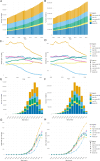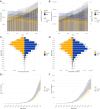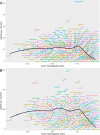The persistent challenge of ischemic stroke burden from high fasting plasma glucose: a global perspective
- PMID: 40395813
- PMCID: PMC12088946
- DOI: 10.3389/fendo.2025.1490428
The persistent challenge of ischemic stroke burden from high fasting plasma glucose: a global perspective
Abstract
Background: Ischemic stroke is a leading cause of disability and mortality worldwide, with high fasting plasma glucose (HFPG) recognized as a critical modifiable risk factor. This study aimed to evaluate the global disease burden of ischemic stroke attributable to HFPG and predict trends over the next 15 years.
Methods: We utilized the comparative risk assessment method from the Global Burden of Disease (GBD) 2021 study to quantify disease burden in terms of deaths, Disability-Adjusted Life Years (DALYs), and their age-standardized rates. The estimated annual percent changes (EAPCs) were calculated to evaluate temporal trends. Additionally, our analysis included health inequality analysis, decomposition analysis, and predictive analysis employing the Bayesian Age-Period-Cohort model (BAPC).
Results: In 2021, the global deaths and DALYs attributable to ischemic stroke due to HFPG were 659,378 (95% UI: 507,502 to 823,945) and 12,371,434 (95% UI: 9,587,506 to 15,382,662), respectively. Notably, both figures have doubled since 1990. Over the past 30 years, both the age-standardized mortality rate (ASMR) and the age-standardized DALY rate (ASDR) have experienced a significant decline, with EAPC of -0.96 (95% CI: -1.05 to -0.86) and -0.72 (95% CI: -0.81 to -0.62), respectively. High-middle and middle Socio-Demographic Index (SDI) regions represented the primary locations of disease burden, while this burden is gradually shifting towards low SDI regions. Furthermore, the burden was more significant in men than in women and was more pronounced in middle-aged and elderly populations compared to younger individuals. Population growth and aging were the principal factors contributing to the increasing disease burden. Additionally, projections indicate that the disease burden will exhibit a downward trend over the next 15 years.
Conclusion: For over 30 years, while ASMR and ASDR have shown a decline, the deaths and DALYs attributable to ischemic stroke resulting from HFPG continue to rise globally. This trend underscores the persistent public health challenge posed by ischemic stroke associated with HFPG. Future targeted medical strategies should prioritize populations beyond those with High SDI, especially concentrating on middle-aged and elderly individuals and male patients.
Keywords: disability-adjusted life years; global burden; high fasting plasma glucose; ischemic stroke; mortality.
Copyright © 2025 Sun, Zhang, Zuo, Li, Li, Zhang and Chen.
Conflict of interest statement
The authors declare that the research was conducted in the absence of any commercial or financial relationships that could be construed as a potential conflict of interest.
Figures








Similar articles
-
Global, Regional, and National Burden of Ischaemic Stroke Attributed to High Fasting Plasma Glucose: An Analysis of Data From 1990 to 2021.Diabetes Metab Res Rev. 2025 Sep;41(6):e70071. doi: 10.1002/dmrr.70071. Diabetes Metab Res Rev. 2025. PMID: 40751694
-
Epidemiological and demographic drivers of ischemic stroke attributed to high fasting plasma glucose from 1990 to 2021: findings from the 2021 global burden of disease study.Front Public Health. 2025 May 19;13:1511518. doi: 10.3389/fpubh.2025.1511518. eCollection 2025. Front Public Health. 2025. PMID: 40458089 Free PMC article.
-
Pancreatic cancer mortality trends attributable to high fasting blood sugar over the period 1990-2019 and projections up to 2040.Front Endocrinol (Lausanne). 2024 Jul 5;15:1302436. doi: 10.3389/fendo.2024.1302436. eCollection 2024. Front Endocrinol (Lausanne). 2024. PMID: 39036051 Free PMC article.
-
Global burden, risk factors, and projections of early-onset dementia: Insights from the Global Burden of Disease Study 2021.Ageing Res Rev. 2025 Feb;104:102644. doi: 10.1016/j.arr.2024.102644. Epub 2024 Dec 17. Ageing Res Rev. 2025. PMID: 39701185 Review.
-
Global, regional, and national burdens of pancreatic cancer attributable to smoking from 1990 to 2021 and the projections to 2035:a systematic analysis from the global burden of disease study 2021.Front Oncol. 2025 May 30;15:1547029. doi: 10.3389/fonc.2025.1547029. eCollection 2025. Front Oncol. 2025. PMID: 40519307 Free PMC article.
References
MeSH terms
Substances
LinkOut - more resources
Full Text Sources
Medical
Miscellaneous

